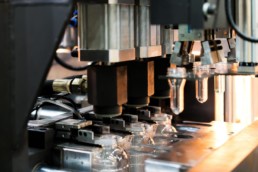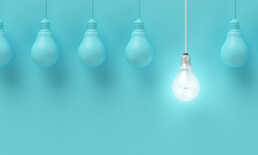COVID-19: Perspective in a Pandemic
Product design comes from the unleashing of creative thinking based on an immediate need. It comes from within but is very much influenced by everything we see, hear, touch and experience. It has been this way since the beginning of time really.
As I sit here writing this, I have a torn ACL, torn MCL, and a fractured tibia. The damage was done over a month ago and there is no option for medical treatment at all. It’s not a medical emergency and in the larger scheme of things with what is happening locally and around the world, it is now seemingly insignificant. Before this COVID-19 outbreak, it would have been a different story and garnered much more attention.
The point is, as humans we focus our energy and effort on the biggest challenge or threat that we face at any given time. In the world of product design, it’s no different. When all is well in the world, we focus on creating products with new innovative features and functionality. Better, stronger, faster….more is better! We create brands with stories and beautiful elaborate packaging that offers a great “unboxing experience” for the consumer. For decades we have been spoiled. We live life in an effort to improve our surroundings and make a better world for our children. In the process, however, we seem to have focussed so much on ourselves. Me, me, me. Bigger homes, nicer cars with fancy new technology and features. More color options, more channels, on-demand. More frequent travel to explore all ends of the earth while still maintaining all the creature comforts we have come to enjoy as spoiled humans. Yep, we have slowly gotten so accustomed to “on-demand” products and services that we have slowly lost touch with the fundamentals of life. In an effort to make life easier and allow us to have more conveniences and more free time, we have actually created a world where we have less time. We are always connected with technology and are burdened with “things”. Rather than freeing ourselves in body and mind to truly live, we have essentially become prisoners of our own making. As a product designer, I can’t help but think about this.
It usually takes a very substantial event to hit home with us and make us re-evaluate life and what it’s really all about. For some, it’s a close call with an illness, maybe the death of a loved one or the loss of a limb. Perhaps a natural disaster. For society as a whole, it can be a world war or a pandemic. Something big….. really big. Bigger than all of us. Something that makes us all change our fundamental thinking and how we approach or lives each day.
Our studio is relatively small. Small enough that we were able to react and respond quickly to the pandemic. We made some quick changes and for over a week now, we have all been working independently off-site in our homes, away from the design studio. It does come with some challenges in communication, but nothing that we cannot adapt to. We had a video conference call as a group on Monday morning to touch base and review the many projects on our plates. It was exciting to see the faces of the team that I have missed seeing in the studio during this time of self-isolation. Yet another reminder that it’s not just about the projects or the products we design. Behind those products is a team of real people. People who see, hear, feel and experience life with friends and loved ones.
In a post-COVID-19 era, I have no doubt that our approach to product design will be modified.
Our thinking will most certainly have more of a global outlook that asks critical questions about the validity of what we are designing. We will be more experienced, more understanding and perhaps more humble in our views. There have been some very eye-opening moments over these past few weeks. Moments where we can all do some self-reflection and look at ways to truly focus on how we can all contribute to a better world, whether through product design or any other endeavour. Going forward, those efforts will surely have more purpose and meaning.
After the dust has settled from the COVID-19 pandemic, the world will be changed. It will surely be a different place with new challenges and renewed focus. I am a firm believer in the notion that through overcoming challenges and difficulty, we gain valuable insight and experience. The type of insight that leads to the creation of more meaningful products. Products that are designed with purpose and meaning. I am personally looking forward to the next chapter and am ready to take it on with renewed energy and an open mind.

What is tooling?
What is tooling?
To put it simply, tooling is the backbone of the physical production of a product. Much like how you could not make muffins without a muffin tin, many consumer products need their own version of a “muffin tin” in order to be mass-produced. For many, this is the non-glamourous side of production but without it, products simply do not exist. The term “tooling” refers to any number of implements required to produce a product.
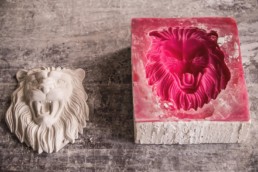

Injection Mold
This is one of the most common forms of tooling. Most commonly, this will be a block of steel or alloy that is precision machined as a negative of the part being produced. In it’s simplest form, it is a two part core & cavity the closes up with hydraulic pressure. A hopper filled with plastic pellets is melted and injected into the cavity under high pressure to take the shape of the part being produced within the mold. Once cooled, the two halves of the mold are separated and the plastic part is ejected from the mold. There is always some post-processing that takes place to remove any bits of plastic from the injection point but essentially, once it is out of the mold, the part is ready for assembly or post-processing which can include painting, chrome plating, or printing with additional elements like a company logo etc. This is how pen caps, food storage containers and your key FOB are produced.
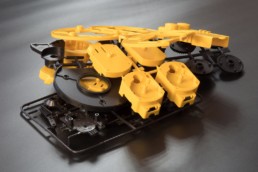

Blow Mold
This is another common form of tooling and one that is simpler in construction than an injection mold because it only requires a cavity and no core. This type of tool is also precision machined from a block of steel or alloy to create a negative of the part being produced. In production, The two halves of the blow mold cavity come together to pinch a curtain of melting plastic, trapping it within mold. A small injector (essentially a needle) also trapped between the two halves, blasts air into the middle of the curtain of melting plastic, sending it outward against the walls of the mold to take the shape of the final product. Once cool, the mold opens up and the part is ejected with a hollow inside. This is how pop bottles, water jugs and oil bottles are produced.


Rotational Mold (Roto Mold)
This is somewhat similar to a blow mold in construction but the process is quite different. With this type of tool, the two cavities come together with a pre-measured quantity of plastic pellets inside the mold. The mold is then heated while being rotated on multiple axis until the plastic with the mold melts and coats the inside of the mold. The process or “cycle time” is much longer than blow molding but it is well suited to producing very large parts and parts that require a thicker wall. This is how some kayaks are made as well as large water holding tanks, children’s playground sets etc.
In its most basic sense, a tool is simply a working or manufacturing aid that is required to make a product or part. They can include dies, gauges, molds, jigs, and cutting equipment. While tools can be used for general purposes (cutting equipment and screwdrivers) in the case of most of our clients, when manufacturers are referring to tooling, it’s generally in a highly specialized sense – as one of the molds mentioned above.


Should this Exist? A short guide to evaluating your idea’s worth
Should this exist?
In our past two decades of helping our clients launch new brands and build upon existing ones, we’ve observed some factors that increase the likelihood of an idea being adopted in the marketplace. If taking note from our clients wasn’t enough, we’ve even decided to introduce a few products of our own. What’s written here is not meant to be a comprehensive guide to launching your new idea but, rather, aims to help you explore the reality of your ah-ha! moment:
Should this exist beyond my imagination?
We don’t mean “should this exist” as a thought-provoking moral dilemma as is often the case on the popular new podcast sharing the title. No, what we’re asking here is, why is this idea worth pursuing? Is it worth the grueling hours that will need to get it off the ground? Is it worth sacrificing the time you could be doing something else? Is it worth the injected plastic that will, one day, end up in a landfill? Whenever we’re going through the process of launching something new, we always start by asking ourselves two important questions:
-
- Why should this be brought into the world?
- Is there an existing alternative that is already solving the problem we’re aiming to?
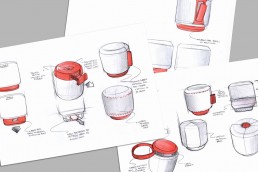

Why should this be brought into the world?
Rather than proposing elaborate new financial models to evaluate the revenue potential of your idea, our objective is simply to prompt you to think about a few key questions prior to committing your energy to chase after your new idea. For most people, the light bulb goes off when a personal need for something arises but, to be viable beyond a personal prototype, you’ll need more than one customer.
Fortunately, there’s never been a better time to launch an idea that connects with small, specialized audiences across the globe. The continual increase in free-flowing information paired with more efficient logistics infrastructure has made niche groups of consumers more accessible than ever. While specialized audiences may be spread thin geographically, they can often be found in tightknit groups online and generally like to share their experiences with the rest of the community. The caveat to this is that specialized groups of category enthusiasts tend to have stronger pre-existing brand loyalty, higher quality expectations, and are very quick to spot imposters who are just stopping by to make a quick buck. If your idea is meant to address the needs of a specialized niche group, authenticity had better be in your game plan.


Whether your idea is specialized or has mass market appeal, to introduce a new product and urge your customers to trade it for their hard earned cash, you’d better have a very compelling story. How is your idea going to contribute to the lives of those who use it? Like a new CRM tool for sales teams, does it help people do more with less? Or, like the output from the entertainment industry, is it based on making people feel good? If your idea doesn’t remove pain points or make a positive contribution to someone’s day, it’s probably time to head back to the drawing board. Unless you have a huge marketing budget to help introduce your idea to the world, you’ll need early support of advocates and this is only made possible by providing a remarkable customer experience. Why not do some preliminary exploration with a sample of your target market before launching headlong after your idea?. When we receive a slow nod and an “I might be interested in that” we know we’re in trouble. While presenting new ideas, we’re looking for jaw-dropping genuine excitement. During the early stages of whatever we’re working on, we refer back to the teachings of Seth Godin and ask ourselves the very basic; is this really worth talking about?


Competition – Do alternatives already exist?
After concluding that an idea has merit and is worth bringing into the world, it’s important to understand the alternatives that are already available. A quick google search is insightful and can help you understand if your new idea isn’t so new, but we advise you go beyond that and identify if there’s anything out there that solves the same problem you’re aiming to.
Access to sourcing websites like Alibaba, intuitive e-commerce platforms like Shopify and the speed at which we can now connect with freelancers on Upwork have made it easy to lay the groundwork of introducing something new to the world. A business can now be started in a local public library and requires little to no mastery. It’s important to remember that, as these barriers are eliminated for you, they’re also being eliminated for your potential competitors. As we continue to build platforms and tools that amplify noise, why is your idea going to stand out from the rest? Remember that long before you compete for sales, you will need to compete for your customer’s attention. Publishing an e-commerce website is one thing, but finding the people to visit it is where the required mastery has now shifted to.


In our years helping brands introduce new ideas and design new products, we’ve realized that there is a major misconception that being better is enough. Does your new knife stay sharp 15% longer than the leading brand at Target? Unfortunately, 15% is not worth a consumer’s cost of switching or the inconvenience it will cause the buyer to move something else off the shelf. Better is only enough when the odds are already in your favor and this isn’t likely to be the case. Often, you’ll find yourself up against brands that have been spending decades building retail relationships, reliable supplier networks, and international brand awareness. Whether it’s a consumer, buyer or investor, the gatekeepers you need to impress with your idea are already busy doing something else and you’ll need to find a way to get their attention. Once you have their attention, you will then need to convince them that your idea is worth the cost of switching. When it comes to launching new ideas in a crowded space, we advise innovators to aim to launch an idea that provides at least a 10X benefit over the next best thing.
Why 10X?
In his work, Understanding the Psychology of New-Product Adoption, John T. Gourville notes that consumers tend to overvalue products they already own by a factor of three while companies tend to overvalue their new products by a factor of three. As a result, there is a 9X mismatch about what developers think consumers want and what consumers actually want. This model uses only psychological biases and doesn’t take into consideration the market advantages possessed by pre-existing competition so we feel it’s safer to strive for a 10X improvement.


With this disconnect in mind, new ideas are likely to fall flat if they’re only 2 or 3X better than the entrenched market players. In order to negate the upper hand the existing competition holds and give an idea a chance to succeed, it needs to deliver substantial benefits. Bookstores already existed when Jeff Bezos decided to start one but he figured out a model that would allow Amazon to have 10x the offering. Dollar Shave Club may not have reinvented the razor, but the sum of experiences it offered consumers certainly hit the 10X marker and rattled the chains of major CPG (Consumer Packaged Goods) companies. How can you build upon your idea to ensure your competitors’ customers will look beyond the psychological costs of switching from what they’re already invested in?


Take a breath
The spark of a new idea is intoxicating and helps power entrepreneurs through the grueling early stages of development but these early stages require the discipline and humility to slow down and ask the tough questions. Whether you’re creating an entirely new category or diving into an older area filled with competition, in order to make it off the ground, new ideas need to be compelling and worth talking about. At this stage, it’s important to remember that we are all biased and are likely overweighing our idea’s benefits by a factor of three. Prior to taking on a new project, we work with our clients to dig deep and help answer two fundamental questions: Should this be brought into the world? And how can we make it at least 10X better than the next best alternative?
Rather than getting discouraged if your idea can’t pass this test, take a breath, head back to the drawing board and work on creating an idea for your users to love. Day in and day out, we work with brands to help them increase the likelihood that their ideas gain traction. If you’re in the early stages of ideation and need some fresh eyes, we’re here to help.
Your competition already has the upper hand. How are you going to take that from them?
List 4 of Section 301 Tariffs
Return to Tension
As trade relations between the U.S and China seem to be further deteriorating, importers are now at risk of facing a 25 percent tariff on over 3,700 products.
On May 13, the U.S Trade Representative (USTR) published its fourth list of proposed Section 301 tariffs on Chinese products imported into the U.S. The list covers $300 billion worth of Chinese imports. Prior to List 4, the Trump administration had tried to make the tariffs less painful to American shoppers by shielding consumer electronics but that is no longer the case. The newest list proposes a 25% tariff on daily use products like cellphones, televisions, clothing, housewares, pens, and strollers.
List 4 can be viewed here and includes most remaining U.S imports which have not been previously assessed Section 301 tariffs.
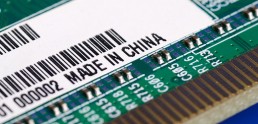

Tariff summary as of May 16, 2019
Warehousing - A guide to receiving, storing, and shipping your inventory
How to receive, store, and ship your products
If you’re planning on shipping a physical product to customers, you’re going to need a location to store your inventory. The type of location you choose will vary depending on the types of customers you need to ship to but, before we get into that, let’s define some of the different warehousing terms you may have come across so far:
Warehouse: A warehouse is a building that is used to store commercial merchandise. Warehouses generally act as longer-term storage solutions and are used by importers, exporters, and wholesalers/distributors. They’re equipped with loading docks so products can be shipped or received by transport trucks. Warehouses can be owned directly by a wholesaler or operated by a Third Party Logistics provider.
Third Party Logistics Facility (3PL): 3PL facilities are outsourced warehousing options used by the majority of Fortune 500 companies. These facilities can receive, hold, and transport products, but they never take possession (ownership) of the goods.
Distribution Center (DC): A distribution center is a specialized warehouse used for temporary storage and redistribution of goods. Mass retailers use a network of distribution centers as a storage center for retail locations to pull inventory from.
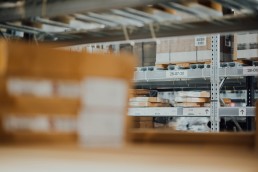

Key Warehouse Considerations
So, your product design is nailed down and your supplier is about to begin production but needs to know where it will be shipping the finished product. What’s next?
Shipment Volume
First, you will need to consider the volume of product you will be receiving. If you have a small business and only plan on receiving a few boxes of product at a time, a local storage facility or your parent’s garage might do just fine. If you plan on receiving pallets, containers, or truckloads, you will need access to a loading dock in a warehouse. Fortunately for small businesses, in North America, there are large networks of third-party logistics facilities that can receive, store, pack and ship your product for you. With these 3PL providers, you will pay a monthly storage fee (usually per pallet) while incurring variable charges for receiving and shipping your product. Many of these service providers work with all sorts of different small business and can provide a helping hand along the way.
Identifying key customers
The second variable to consider is who your customers are. Online sellers that are are shipping directly to consumers can often operate cost-effectively right out of their garages until the volume becomes too much to handle, Small businesses working with mass retailers, on the other hand, are often required to ship product on pallets which means they will need to have access to a shipping door at an owned warehouse or 3PL facility. To make your life easier, it will be important to select a 3PL provider that already has experience working with the retailers you will be shipping to. This can save time while avoiding financial penalties of improperly shipped product.
In the early stages of your business, it’s important not to overextend yourself. If you don’t yet need the services provided by a 3PL, there’s no harm in starting small in the space you already have (spare room, garage, ect). As the volume starts to pick up and you find yourself in a time crunch, it might be wise to consider moving your inventory to a 3PL facility or even moving into an office with warehousing space and loading docks while bringing on experienced personnel to manage the logistics side of your business.
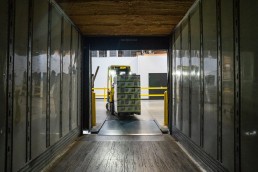

Choosing a Storage Location
If you’ve decided that working with a 3PL facility is the best option for your business, the next step is determining the best location for your inventory to be stored. This requires a balance between proximity to supply and proximity to demand. Warehousing in the Los Angeles area can be a great option as it’s close to the shipping ports and provides a cost-effective option for receiving inventory from Asia, however, if the majority of your customers are on the East Coast, your FedEx bills will quickly erase any gains in freight savings. For our consumer brands with higher volume, we usually activate a 3PL facility on the East Coast and one on the West Coast. The price to get a container to the east coast is higher but we make up for it very quickly in savings on direct-to-consumer shipments.
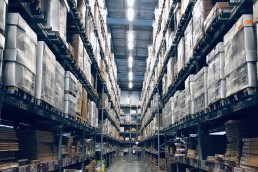

Understand Your Costs
Every business has different needs and there are many factors to take into consideration when determining how to store and ship your products. Spend the time building out different models to give yourself a full understanding of where your costs will be coming from and where there are opportunities for increased efficiency. While it’s important to choose a solution that allows you to scale, remember not to overburden yourself so much early on that you don’t have the resources to invest in growing your business.
The U.S - China Trade Conflict Timeline
The U.S - China Trade Conflict Timeline
A few months ago, we wrote a piece on what was the escalating trade tensions between China and the United States. The conflict is an ongoing topic of debate so we’ve decided to reformat in order to make sure you have the most up to date information for your business. Because you likely don’t have hours to mull over all of the threats and drama between Xi and Trump, we’ve condensed the timeline into, what we consider to be, the most important developments.


Many import businesses already have teams in place and are optimized for working with China so switching manufacturing to other countries can be a huge headache. While these trade disputes have generated very little good news for importers, fortunately, most of your competitors are experiencing similar issues and the new tariffs likely haven’t given you a competitive disadvantage. We’re optimistic that some face-to-face time at the G20 will help settle some tensions between Trump and Xi but these past few months have served as a great reminder of just how fickle major economic relationships can be. This fragile nature of trade has exposed the dangers of an overly concentrated manufacturing network and has taught us that there is really no such thing as a status quo.
As of this writing, the United States has imposed tariffs on $250 billion worth of Chinese exports. The complete lists of affected goods can be found below:


The Timeline
October 25
Trade talks resumed between the two countries. Trump and Xi are reported to be planning discussions to take place during November’s G20 summit in Argentina.
September 24
The US instated tariffs on List 3, affecting $200b worth of Chinese goods. As of September 24, the total value of goods affected by these new tariffs was $250b.
China responded by instating its proposed tariffs on $60b worth of US goods.
September 17 2018
USTR announced that there would be a 10% tariff on the $200b worth of Chinese exports that will go into effect on from Sept 24- Dec 31. Starting early 2019, the tariff rate on that list was proposed to increase to 25%. Immediately afterwards, China announced that it would impose tariffs on an additional $60b of US goods that would go into effect at the same time.
August 23
The US and China go forward and implement tariffs on $16b worth of goods in List 2.
August 3
In retaliation to the United States’ proposed List 3, China proposed a range of tariffs that would affect $60 billion in US products
August 2
President Trump begins considering a 25 percent tariff on $200 billion worth of goods on List 3 as opposed to the original proposed 10 percent.This list included consumer products, construction materials, tools, agricultural products and commercial electronics equipment.
July 6 2018
As promised, the US and China both move forward with tariffs on the initial $34 billion in imports (List1). During this time, a second round of tariffs to impact $16b in goods on each side is under review (List 2).
June 18 2018
President Trump threatened a 10% tariff on an additional $200 billion in Chinese products. He also stated that another $200 billion would be imposed if China retaliated further. At this stage, the threats pretty much covered all of the United States annual $505.47 billion in Chinese imports.
May 29 2018
The United States announced that it would be moving ahead with its proposed tariffs on $50 billion of imports while also announcing a plan to limit visas for Chinese citizens in an attempt to protect intellectual property.
May 20 2018
The United States and China appear to reach an agreement after China offered to significantly increase purchases goods of U.S origin.
May 3 2018
The United States and China began engaging in trade talks in Beijing. Here, the U.S demanded a trade gap reduction of US$200 billion within the next two years. No agreement was reached.
April 4 2018
In response to the U.S government’s tariff implementation, the Chinese government announced a list of US origin products that will be subject to an addition 25% tariff which would also come into play on July 6 2018. The list covers $34 billion in Chinese imports from the US and can be viewed (in Mandarin) here.
April 3 2018
The U.S Trade Representative (USTR) announced the first list of products that would be impacted. That list contained 818 product lines comprised mostly of non-consumer products and included industries such as aerospace, technology, robotics, industrial machinery, medical equipment, and automobiles. The complete first list represented $34 billion in products and was set to be in effect as of July 6, 2018.
March 22, 2018
President Trump first announced that the United States would be imposing a 25% tariff hike that would impact $50 billion in Chinese goods imported into the U.S annually.
U.S - China Tariffs Explained
Trade Tensions
No matter which outlets you subscribe to, your newsfeed is undoubtedly filled with talk of the increasing economic tensions between the United States and China. Given that this is a resource for entrepreneurs and I’m not here to debate who the long-term economic winners and losers or predict the impact on international trade as a whole. The purpose of the post is simply to review what has been said, what has been put in motion and help you identify if there will be any immediate impacts on your business.
President Trump first announced on March 22, 2018, that the United States would be imposing a 25% tariff hike that would impact $50 billion in Chinese goods imported into the U.S annually. On April 3rd the U.S Trade Representative (USTR) announced the first list of products that would be impacted. That list contains 818 product lines comprised mostly of non-consumer products and includes industries such as aerospace, technology, robotics, industrial machinery, medical equipment, and automobiles. The complete first list represents $34 billion in products and will be effective as of July 6, 2018. You can see the full list of product lines here.
The second list covers 284 lines worth $16Billion in annual imports is currently under further review and does not yet have an effective date. The second list can be found here.
More threats
In response to the U.S government’s tariff implementation, the Chinese government has announced a list of US origin products that will be subject to an addition 25% tariff which will also come into play on July 6 2018. The list covers $34 billion in Chinese imports from the US and can be viewed (in Mandarin) here.
In response (yes, again) to the Chinese government’s tariff implementation, on June 18th President Trump threatened a 10% tariff on an additional $200 billion in Chinese products. He also stated that another $200 billion would be imposed if China retaliates further. These threats pretty much cover all over the United States annual $505.47 billion in Chinese imports. As of this writing, no product lines or official documentation have been released pertaining to these threats.
The trade landscape between China and the United States is changing very quickly so be sure to stay in the loop and monitor how these changes will affect your business.


